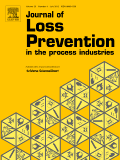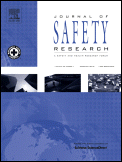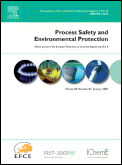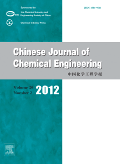
JOURNAL OF LOSS PREVENTION IN THE PROCESS INDUSTRIES
Scope & Guideline
Enhancing operational excellence with interdisciplinary insights.
Introduction
Aims and Scopes
- Risk Assessment and Management:
The journal highlights methodologies for assessing and managing risks in various industrial processes, including quantitative risk analysis and probabilistic models. - Explosion and Fire Safety Research:
A core area of focus is the investigation of explosion and fire dynamics, including studies on dust explosions, gas explosions, and fire suppression techniques. - Human Factors and Safety Culture:
Research on human behavior, safety culture, and organizational factors that contribute to accidents is emphasized, aiming to improve safety practices in industrial settings. - Innovative Safety Technologies:
The journal covers the development and application of innovative technologies for safety management, including computational fluid dynamics (CFD), machine learning, and advanced materials for hazard prevention. - Regulatory and Compliance Issues:
It addresses regulatory frameworks and compliance challenges within the process industries, providing insights into best practices for safety management. - Environmental and Occupational Safety:
The journal also explores the intersection of environmental safety and occupational health, promoting safer practices in the handling of hazardous materials.
Trending and Emerging
- Data-Driven Risk Management:
There is a growing trend towards utilizing data analytics and machine learning for risk management and predictive modeling, enhancing the ability to foresee and mitigate potential accidents. - Sustainability and Inherent Safety:
Research focusing on sustainability and inherently safer design principles is on the rise, reflecting an industry-wide shift towards minimizing environmental impact and enhancing safety from the design phase. - Cybersecurity in Process Safety:
As industries become more digitized, the intersection of cybersecurity and process safety is emerging as a critical area of study, addressing vulnerabilities in automated systems. - Integrated Safety Management Systems:
There is an increasing focus on the integration of occupational safety and process safety management systems, promoting a more comprehensive approach to safety. - Advanced Materials for Explosion Prevention:
Studies exploring the use of advanced materials and coatings for explosion prevention and fire suppression are trending, showcasing innovation in safety technologies.
Declining or Waning
- Traditional Risk Assessment Models:
There has been a noticeable decline in publications focused on traditional risk assessment models, as researchers are increasingly adopting more complex and integrated approaches that incorporate machine learning and advanced statistical techniques. - Basic Fire Safety Codes:
Research centered on basic fire safety codes and regulations has waned, possibly due to a shift towards more innovative safety technologies and practices that go beyond conventional codes. - Single-Factor Risk Studies:
Studies focusing solely on single-factor risks without considering multi-hazard scenarios or comprehensive risk assessments are becoming less common, reflecting a trend towards more holistic approaches.
Similar Journals

QUALITY AND RELIABILITY ENGINEERING INTERNATIONAL
Elevating Standards in Quality and Reliability ResearchQUALITY AND RELIABILITY ENGINEERING INTERNATIONAL is a prestigious journal published by WILEY, dedicated to advancing the fields of quality, reliability, and engineering. With an ISSN of 0748-8017 and an E-ISSN of 1099-1638, this journal provides a platform for scholarly articles that delve into the intricacies of management science, operations research, safety, risk, reliability, and quality, as evidenced by its strong ranking in the Q2 category for both Management Science and Operations Research, as well as Safety, Risk, Reliability, and Quality. Established in 1985 and continuing through 2024, the journal has garnered a solid reputation in the academic community, achieving a Scopus ranking in the 70th and 64th percentiles for its respective categories. Although it does not offer open access, its authoritative content is essential for researchers, professionals, and students seeking to deepen their understanding of quality and reliability principles. With its UK-based publishing address ensuring global reach, this journal remains at the forefront of discussions surrounding engineering quality and reliability methodologies.

JOURNAL OF SAFETY RESEARCH
Transforming safety discourse with empirical findings.The JOURNAL OF SAFETY RESEARCH, published by Pergamon-Elsevier Science Ltd, stands as a premier platform for scholarly discourse within the domain of safety, risk, reliability, and quality. With an esteemed impact factor and a strong ranking of #38 out of 207 in its category as per Scopus, this journal maintains a distinguished Q1 quartile status, reflecting its influence and significance in advancing safety research since its inception in 1969. Researchers, practitioners, and students alike will find a wealth of knowledge here as the journal explores critical aspects of safety in various contexts, highlighting innovative strategies and empirical findings that contribute to improved safety outcomes globally. Though it operates under a traditional access format, the journal’s extensive repository of articles ensures that vital information remains accessible to its readership. The JOURNAL OF SAFETY RESEARCH is not only a cornerstone for those within the safety engineering field, but also a vital resource for professionals seeking to enhance their understanding of risk management and quality assurance methodologies.

Journal of Health and Safety at Work
Exploring the intersection of health, safety, and environmental management.The Journal of Health and Safety at Work, published by the Iranian Occupational Health Association, is a vital resource for researchers, professionals, and students engaged in the fields of occupational health, safety, and environmental management. With an ISSN of 2251-807X and E-ISSN 2383-2088, this Open Access journal has been dedicated to disseminating knowledge since 2012, ensuring that critical research is accessible to a global audience. The journal’s scope encompasses a diverse range of topics including human factors and ergonomics, safety research, and public health, with a focus on enhancing workplace safety and environmental standards. Although currently positioned in the Q4 category across various disciplines within safety and health research, the journal offers a unique platform for emerging studies and innovative practices, making it a significant contributor to the discourse in these fields. The journal's commitment to open access aligns with the growing trend of transparent scholarship, thus facilitating the sharing of vital insights to improve workplace health and safety outcomes. Researchers aiming to publish groundbreaking studies in this pivotal area will find the Journal of Health and Safety at Work an indispensable avenue for advancing knowledge and fostering professional collaboration.

Proceedings of the Institution of Mechanical Engineers Part O-Journal of Risk and Reliability
Exploring New Frontiers in Safety and Quality Assurance.Proceedings of the Institution of Mechanical Engineers Part O – Journal of Risk and Reliability is a highly regarded journal published by SAGE Publications Ltd, specializing in the critical fields of Safety, Risk, Reliability, and Quality. Established in 2006 and extending its coverage until 2024, this journal serves as a vital platform for researchers and professionals to disseminate innovative findings and discuss emerging trends and methodologies related to risk assessment and reliability engineering. With an impact factor that places it in the Q2 quartile of its category and ranked 69th out of 207 in Scopus, it has garnered significant attention within the academic community, ensuring robust visibility and influence. Readers can expect rigorous peer-reviewed articles that contribute to advancing knowledge and practices in the field, fostering a deeper understanding of the complexities and integral practices essential for safety and reliability. As a leading publication within the United Kingdom, it continues to play an instrumental role in shaping contemporary discussions and research in this vital sector.

Production Engineering Archives
Unlocking Knowledge in Manufacturing ExcellenceProduction Engineering Archives, published by WALTER DE GRUYTER GMBH, stands as a premier open access journal dedicated to the fields of industrial and manufacturing engineering, management information systems, and the management of technology and innovation. Since its inception in 2013, this journal has committed itself to disseminating high-quality research that drives forward the discourse in these crucial areas. With a commendable impact reflected in its 2023 Category Quartiles, which place it in Q2 for multiple categories including Industrial and Manufacturing Engineering and Management Information Systems, the journal holds esteemed ranks in the Scopus index, highlighting its significance in the academic community. By facilitating unrestricted access to cutting-edge research from Poland and beyond, the Production Engineering Archives plays a pivotal role in enhancing knowledge and fostering innovation among researchers, professionals, and students alike.

International Journal of Maritime Engineering
Navigating the Future of Maritime InnovationThe International Journal of Maritime Engineering (ISSN: 1479-8751, E-ISSN: 1740-0716), published by UNIV BUCKINGHAM PRESS in the United Kingdom, is a vital resource for the maritime engineering community, addressing pressing issues in both Environmental Engineering and Ocean Engineering. Established in 2006, this journal serves as a platform for disseminating innovative research, technological advancements, and practical solutions that enhance the sustainability and efficiency of maritime operations. With its current classification in the Q3 quartile for both fields in 2023, it offers valuable insights to researchers, professionals, and students who seek to bridge theoretical knowledge with industry applications. Though the journal does not operate under an open access model, it remains an essential reference for academic discourse and advancement in maritime studies through its rigorous peer-review process and high-level research outputs.

PROCESS SAFETY AND ENVIRONMENTAL PROTECTION
Fostering interdisciplinary solutions for a sustainable future.PROCESS SAFETY AND ENVIRONMENTAL PROTECTION, published by Elsevier, is a premier academic journal dedicated to advancing the fields of chemical engineering, environmental science, and safety management. With an impressive impact factor, this esteemed journal undergoes a meticulous peer-review process and serves as a vital platform for researchers, professionals, and students seeking to disseminate cutting-edge research and innovative practices. Submissions are welcome in a wide scope of topics related to safety, risk, reliability, and environmental engineering, demonstrating its influence as a Q1 journal across multiple categories, including Environmental Chemistry and Safety, Risk, Reliability and Quality. By providing a rigorous analysis of current challenges and solutions in the domain since its inception in 1990, it continues to foster interdisciplinary collaboration and practical applications in the United Kingdom and beyond. With the journal not currently offering Open Access options, subscribers gain exclusive access to pivotal insights that shape industry standards and drive advancements in sustainable practices.

Chinese Journal of Chemical Engineering
Fostering Innovation in Chemical Engineering and BeyondChinese Journal of Chemical Engineering, published by CHEMICAL INDUSTRY PRESS CO LTD, is a premier academic journal dedicated to advancing the field of chemical engineering and related disciplines. With a strong emphasis on innovative research and practical applications, the journal spans a wide range of topics including biochemistry, environmental engineering, and general chemistry. Boasting a commendable impact factor and a consistent presence in Q2 quartiles across multiple categories, it ranks impressively in Scopus, notably positioned in the top percentile of its fields, enhancing its credibility and reach among the scientific community. Published continuously since 1993 and converging towards its 2024 goals, the journal remains committed to fostering sustainable and impactful research. Researchers, professionals, and students alike will find invaluable resources and cutting-edge insights, making the Chinese Journal of Chemical Engineering an essential platform for disseminating pivotal work in the realms of chemical and environmental sciences.

Journal of the Pakistan Institute of Chemical Engineers
Transforming Ideas into Impactful Engineering Solutions.The Journal of the Pakistan Institute of Chemical Engineers serves as a pivotal platform for advancing the field of chemical engineering within Pakistan and beyond. Published by the Pakistan Institute of Chemical Engineers, this journal aims to disseminate high-quality research, reviews, and case studies that cover a wide scope of topics relevant to chemical engineering, including process design, environmental technology, and materials science. Although it operates under a non-open access model, the journal is committed to maintaining rigorous peer-review standards to ensure the publication of impactful articles that contribute to the advancement of knowledge and best practices in the discipline. As a hub for researchers, professionals, and students alike, this journal not only fosters academic collaboration but also plays an integral role in shaping the future of chemical engineering in the region. With an ISSN of 1813-4092, it is dedicated to enhancing the visibility and accessibility of chemical engineering research, promoting innovation and education within the field.

Journal of Structural Fire Engineering
Transforming knowledge into fire safety practices.The Journal of Structural Fire Engineering is a premier academic publication dedicated to advancing the field of fire safety and structural engineering. Published by Emerald Group Publishing Ltd, this journal features high-quality research and innovative solutions addressing crucial aspects of safety, risk, reliability, and the mechanics of materials. With an impact factor that reflects its growing influence in the academic community and a classification in the Q3 quartile across several engineering categories, the journal plays a vital role in disseminating knowledge that bridges theoretical concepts and practical applications. With coverage spanning from 2010 to 2024, researchers, professionals, and students can access a wealth of studies that explore the intersection of structural integrity and fire safety. While it currently operates under a subscription model, the journal remains committed to sharing pivotal insights that drive forward the discipline. Join the community of experts striving to enhance engineering practices and resilience against fire-related hazards.